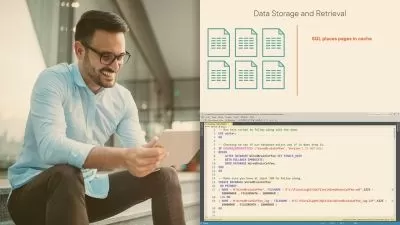Introduction to Databases, Data Modeling and SQL
John McTiernan
3:44:58
Description
learn basics of data modeling, how to build your model in a database and interact with that data using SQL
What You'll Learn?
- Understand what a database is and what its used for
- The difference between Structured and unstructured data
- Understanding of an ERD (Entity Relationship Diagram) and how to "model" your data
- Learn how to create and manage tables using SQL (structured query language)
- Learn most common types of SQL commands: Select, Insert, Update, Delete
- Understand different types of table joins
Who is this for?
What You Need to Know?
More details
DescriptionThis class is designed for anyone involved in software development, with a focus on those new to the concepts of Data Modeling and Structured Query Language (SQL) . At DT Group, we believe application development is about more then just code. The more all members of an application development team understand the other roles, the more effect each member of the team will become.
In this class, we will walk through concepts of data modeling. Â This includes the following topics:
Understand the difference between Structured and Unstructured Data
Learn how to take a know concept ( we will use a Student) to build a Data Model to store relevant data
Understand common mistakes in data modeling and how to correct them
Learn how to represent this data model in an industry standard format (Entity Relationship Diagram, or ERD)
Learn how to build the data model in the database using Structured Query Language (SQL)
Learn how to interact with your data model using SQL, including the most common SQL commands (Insert, Update, Delete, Select)
Understand the different types of relationships between tables (Joins) and how to use these in SQL
Regardless of your role within the SLDC, a deeper understanding of data modeling and data interactions will dramatically improve the quality of your work and the software delivered.
I hope you enjoy!
NOTE:
In this class, we will be using a PostgreSQL database and learning SQL commands formatted specific for this type of database.  The concepts are applicable to many other databases (MySQL, Oracle, and others), but the syntax will be slightly different.
This is a hands on class, where you will install and interact with a database on your own system .  Please make sure you have at least 2 GB of free space on your computer and the ability to install software.
Who this course is for:
- New developers who are looking to learn or improve their skills in modeling and working with data
This class is designed for anyone involved in software development, with a focus on those new to the concepts of Data Modeling and Structured Query Language (SQL) . At DT Group, we believe application development is about more then just code. The more all members of an application development team understand the other roles, the more effect each member of the team will become.
In this class, we will walk through concepts of data modeling. Â This includes the following topics:
Understand the difference between Structured and Unstructured Data
Learn how to take a know concept ( we will use a Student) to build a Data Model to store relevant data
Understand common mistakes in data modeling and how to correct them
Learn how to represent this data model in an industry standard format (Entity Relationship Diagram, or ERD)
Learn how to build the data model in the database using Structured Query Language (SQL)
Learn how to interact with your data model using SQL, including the most common SQL commands (Insert, Update, Delete, Select)
Understand the different types of relationships between tables (Joins) and how to use these in SQL
Regardless of your role within the SLDC, a deeper understanding of data modeling and data interactions will dramatically improve the quality of your work and the software delivered.
I hope you enjoy!
NOTE:
In this class, we will be using a PostgreSQL database and learning SQL commands formatted specific for this type of database.  The concepts are applicable to many other databases (MySQL, Oracle, and others), but the syntax will be slightly different.
This is a hands on class, where you will install and interact with a database on your own system .  Please make sure you have at least 2 GB of free space on your computer and the ability to install software.
Who this course is for:
- New developers who are looking to learn or improve their skills in modeling and working with data
User Reviews
Rating
John McTiernan
Instructor's Courses
Udemy
View courses Udemy- language english
- Training sessions 40
- duration 3:44:58
- Release Date 2024/05/17

















